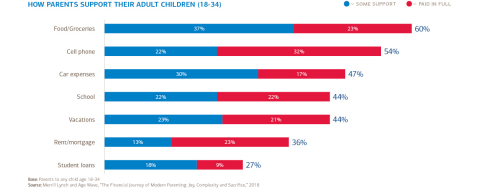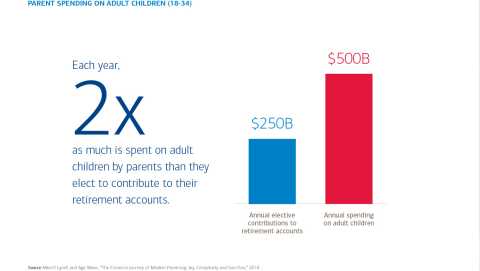NEW YORK--(BUSINESS WIRE)--Parents in the U.S. now spend $500 billion annually on their 18- to 34-year-old adult children – twice the amount they contribute each year to their retirement accounts ($250 billion)1, according to a new Merrill Lynch study conducted in partnership with Age Wave. The study also found that nearly two-thirds of parents report having sacrificed their own financial security for the sake of their children. Even with the financial challenges and sacrifices, over 90 percent of parents say that parenting is the most rewarding aspect of their lives.
There are 173 million parents in the United States today, 76 million with children under 18.2 While 89 percent agree there is “no normal” when it comes to parenting, there are common patterns as the journey unfolds. “The Financial Journey of Modern Parenting: Joy, Complexity and Sacrifice” takes an in-depth look at the financial and emotional journey of contemporary parenting. This study marks the third in a multi-year research series from Merrill Lynch and Age Wave that examines five distinct life stages: early adulthood, parenting, caregiving, widowhood, and end of life/legacy.
“Parenting can be one of the most fulfilling and identity-shaping experiences of a person’s life – and with it comes a lifelong financial commitment,” said Lorna Sabbia, head of Retirement and Personal Wealth Solutions for Bank of America Merrill Lynch. “Planning ahead for the major financial costs can limit surprises down the road and help parents safeguard their own financial goals.”
The study surveyed more than 2,500 respondents in the United States who are over age 18 and a parent to one or more children – biological, adopted or step – of any age. Key findings include:
- Parental purpose is raising happy, self-sufficient children. With infants and toddlers, parents say they are primarily nurturers and protectors, and the majority (52 percent) say this is the most rewarding stage of parenting. The most challenging phase is with middle to high school age children, when parents play a variety of roles to help their kids move towards independence, including teacher, cheerleader and ATM. As children become independent adults, parents become advisors and friends, and often financial supporters.
- Finances increasingly influence when – or if – to have children. Today, 73 percent of people factor finances into their decision to become a parent. In contrast, in the 1980s, only one-third of people took finances into consideration when starting a family.
- The costs of parenting are surprising and steep. The average cost of raising a child to age 18 is now estimated to be over $230,000.3 Nine in 10 parents are surprised by how much money they spent after becoming a parent, and nearly two-thirds report encountering financial difficulties associated with parenting.
- Traditional female/male parenting roles still predominate. Even in this era of increasing gender equality, women take 10 times as much temporary leave from work as men take upon the arrival of a child.4 This can result in lasting financial ramifications for women due to loss of income and benefits, missed raises/promotions, and lost opportunities to fund their 401(k) and Social Security, as underscored in the recent Merrill Lynch and Age Wave study, Women and Financial Wellness: Beyond the Bottom Line. On the other hand, upon becoming a parent, men are more than twice as likely as women to switch to higher-paying jobs with better benefits, work longer hours, or take on a second job to bring in more money.
- Beyond boomerang: the hidden economy of ongoing support for adult children. Seventy-nine percent of parents of early adults now provide them some type of financial support. Thirty-one percent of early adults ages 18-34 live with their parents, more than the percentage who currently live with a spouse.5 However, even if their child is living independently, today’s parents often contribute to school costs, health insurance, rent, and car expenses – and even food, groceries and cell phone service. (See Figure below for details). In addition, 59 percent expect to help pay for their children’s weddings, 26 percent expect to contribute to their children’s first homes, and one-third plan to contribute to their grandchildren’s college costs.
- Parents need – and want – help with financial parenting. The study revealed a significant disconnect between what parents think they are teaching their children and what teenage children report learning. For example, while 59 percent of parents believe they taught their children the benefits of investing, only 31 percent of teenagers reported having learned about it from their parents. Nearly three-fourths of parents wish they had help teaching their children about investing, and 90 percent of parents say they’d like personal finances to be taught to children in school.
- The family bank may be overdrawn. Seventy-two percent of parents say they have put their children’s interests ahead of their own need to save for retirement, and 82 percent say they would be willing to make a major financial sacrifice for adult children, including drawing down savings (50 percent) or curtailing their lifestyles (43 percent). One-fourth would take on debt or pull money from retirement accounts.
According to Ken Dychtwald, Ph.D., CEO and founder of Age Wave, “In this new era of delayed financial independence of young people, financial planning is no longer a solo or coupled activity. It’s become an ongoing family project with longer and different social, housing and economic interdependencies than we’ve seen before.”
Lisa Margeson, head of Retirement Client Experience and Communications at Bank of America Merrill Lynch reflects, “When emotions and money become intertwined, parents risk making financial decisions that can compromise their – and their children’s – financial futures. Parents can navigate this difficult balance by setting clear boundaries about their level of support, fostering financial independence in adult children, and reconciling spending on children with long-term savings goals to avoid jeopardizing their own financial security.”
1 Calculation based on parents’ contributions as reported by
their adult children ages 18-34 across 14 expense categories and IRS
data on employees’ elective contributions to the full range of
retirement accounts.
2 Census Bureau, 2017; Age Wave
estimate, 2017
3 U.S. Department of Agriculture,
Expenditures on Children by Families, 2017
4 Pew
Research Center, 2018
5 Census Bureau, Historical Living
Arrangements of Adults: 1960 to Present, 2017
Age Wave
Age Wave is the nation’s foremost thought leader on
population aging and its profound business, social, financial, health
care, workforce, and cultural implications. Under the leadership of
Co-founder Dr. Ken Dychtwald, CEO, Age Wave has developed a unique
understanding of new generations of maturing consumers and workers and
their expectations, attitudes, hopes, and fears regarding their longer
lives. Since its inception in 1986, the firm has provided breakthrough
research, compelling presentations, award-winning communications,
education and training systems, and results-driven marketing and
consulting initiatives to over half the Fortune 500. For more
information, please visit www.agewave.com.
(Age Wave is not affiliated with Bank of America Corporation or Merrill
Lynch.)
Merrill Lynch Wealth Management
Merrill Lynch is a leading provider
of comprehensive wealth management and investment services for
individuals and businesses globally. With 14,820 financial advisors and
$2.3 trillion in client balances as of June 30, 2018, it is among the
largest businesses of its kind in the world. Bank of America
Corporation, through its subsidiaries, specializes in goals-based wealth
management, including planning for retirement, education, legacy, and
other life goals through investment, cash and credit management. Within
Merrill Lynch, the Private Banking and Investment Group focuses on the
unique and personalized needs of wealthy individuals, families and their
businesses. These clients are served by approximately 200 highly
specialized private wealth advisor teams, along with experts in areas
such as investment management, concentrated stock management and
intergenerational wealth transfer strategies. Merrill Lynch is part of
Bank of America Corporation. For more information, please visit https://www.ml.com/financial-goals-and-priorities.html.
Bank of America
Bank of America is one of the world’s leading
financial institutions, serving individual consumers, small and
middle-market businesses and large corporations with a full range of
banking, investing, asset management and other financial and risk
management products and services. The company provides unmatched
convenience in the United States, serving approximately 67 million
consumer and small business clients with approximately 4,400 retail
financial centers, including more than 1,700 lending centers, more than
1,900 Merrill Edge investment centers and more than 1,300 business
centers; approximately 16,100 ATMs; and award-winning digital banking
with more than 36 million active users, including 25 million mobile
users. Bank of America is a global leader in wealth management,
corporate and investment banking and trading across a broad range of
asset classes, serving corporations, governments, institutions and
individuals around the world. Bank of America offers industry-leading
support to approximately 3 million small business owners through a suite
of innovative, easy-to-use online products and services. The company
serves clients through operations across the United States, its
territories and more than 35 countries. Bank of America Corporation
stock (NYSE: BAC) is listed on the New York Stock Exchange.
Bank of America Merrill Lynch is a marketing name for the Retirement Services business of Bank of America Corporation (BofA Corp). Banking activities may be performed by wholly owned banking affiliates of BofA Corp, including Bank of America, N.A. (BANA), member FDIC. Certain associates are registered representatives with Merrill Lynch, Pierce, Fenner & Smith Incorporated (MLPF&S) – a registered broker-dealer, member SIPC, and wholly owned subsidiary of BofA Corp.
Investment products offered through MLPF&S and insurance and annuity products offered through MLLA:
| Are Not FDIC Insured | Are Not Bank Guaranteed | May Lose Value | ||||||||||
© 2018 Bank of America Corporation. All rights reserved.
For more Bank of America news, including dividend announcements and other important information, visit the Bank of America newsroom. Click here to register for news email alerts.





